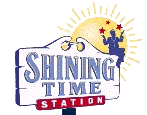
EPISODES Season 1 Seasons 2 & 3 MUSIC Theme Song Jukebox Band Pictures TV schedule Facts |
Thomas the Tank Engine History (written by Ian Gunn)Thomas the Tank Engine is fifty years old. The stories were first created by an Anglican clergyman, the Reverend Wilbert Awdry, as a way of entertaining his young son Christopher as he recovered, in isolation, from scarlet fever. Christopher demanded that he be told the stories again and again and, in the way of small children, corrected his father whenever inconsistencies crept into the retold stories. In self defense, the Rev. Awdry wrote the first stories down on available scraps of paper. To add to the story telling, the Rev. Awdry drew simple pictures of steam locomotives on the paper along with the stories. A head on view being the easiest to draw, he drew a row of locomotives standing in an engine shed with a human face and expression on each locomotive's smokebox door. "Why is this engine sad, Daddy?", asked Christopher, pointing at an unhappy faced locomotive. "Because he's old and tired and he hasn't been out in a long time.", replied his father. "What's his name, Daddy?" "Edward" was the first name that came into the Rev. Awdry's mind. This was the genesis of "Edward's Day Out", the first in almost a hundred simple moral tales about the exploits and adventures of a group of railway engines given human personalities. Mrs Awdry believed that these children's stories had some merit and so pestered her husband to "do something about them". Through a distant cousin a small publisher, Edmund Ward, was found who was interested in these railway stories. The connection was made so suddenly that the Rev. Awdry had to send the stories as they were written on scraps of paper as the original manuscript. In 1945 the first of the Railway Series of books "The Three Railway Engines" appeared. This was a book, small enough for children's hands, containing three stories, "Edward's Day Out" being the first. The book was laid out with the text on the left hand page and a full page illustration of an incident in the story on the right. Thomas the Tank Engine did not appear until the second book was published a year later in 1946 and more books followed at yearly intervals. The illustrator for the first dozen or so books was C. Reginald Dalby, who established the basic appearance of each locomotive character from the Rev. Awdry's sketches and by looking at real steam engines in use in Britain at that time. Thus an obscure 0-6-0T Class E2 shunting engine built in the Victorian era for the London, Brighton and South Coast Railway became the model for Thomas, now known to millions of children worldwide. Gordon can be seen to be based on a Gresley A3 Pacific from the London and North Eastern Railway; Flying Scotsman being the most famous real locomotive of this class. As the stories developed, the location and other features of fictional railway system emerged. Many stories were based on actual happenings on British Railways and its predecessors. A railway locomotive did disappear down a mine shaft on the Furness Railway and get spun on a turntable by the wind: Midland Railway. More than one of the Reverend Awdry's clerical colleagues were just as fascinated as he with steam powered machinery. The Rev. Terry Boston was a well known collector of steamrollers and became the inspiration for the vicar who saves Trevor the Traction Engine from the scrap heap. More locomotive characters appeared, learning to deal with the troublesome trucks and to become "really useful engines" as they pulled their trains over the railway system presided over by the stern but kindly Fat Controller: Sir Topham Hatt. The now famous engines all went to London and the Queen came to visit the railway. By the time British Railways retired its last steam locomotive, the Rev. Awdry had firmly established the Island of Sodor as the location of his railway, happily unaffected by the modernization on the mainland. After twenty six books, the Rev. Awdry laid down his pen, only to have it taken up by his son Christopher, who is now continuing to write stories for his son. Ten more books of the Railway Series have now appeared so far under Christopher's name. Perhaps, in his turn, the Rev. Awdry's grandson will continue the tradition! During the 1960's the Rev. Awdry built a model of Thomas's branch line and exhibited it at various model railway shows throughout England. It wasn't until 1984 that a whole new generation of children were introduced to Thomas the Tank Engine and Friends when the first of the T.V. series of that name was made. Gauge 1 models based on Marklin mechanisms were used in the making of the T.V. shows in a studio not far from Clapham Junction, Britain's busiest railway station. In response to the rekindled interest in Thomas, a British Model Railway Manufacturer, Hornby Railways, introduced a number of OO gauge models of the locomotives in the Railway Series.
|